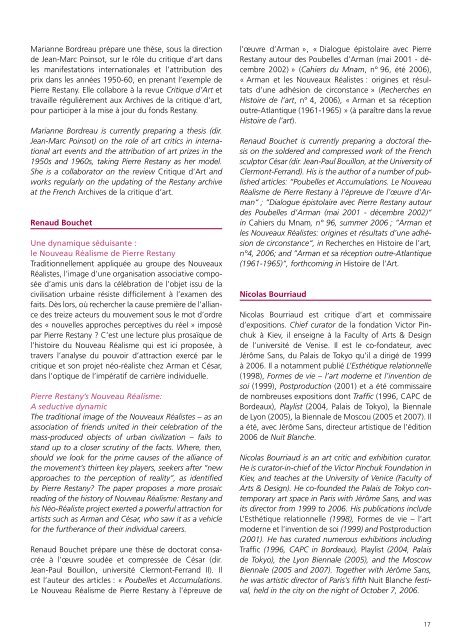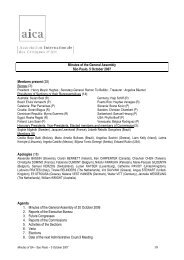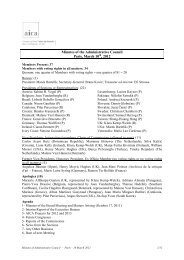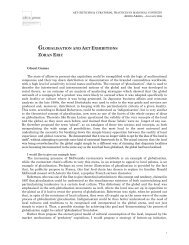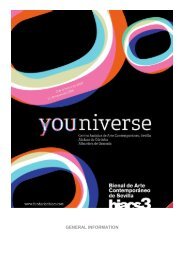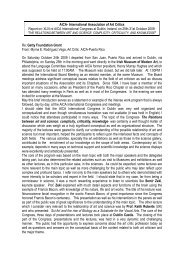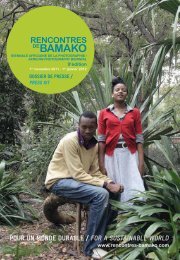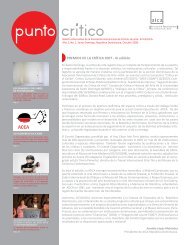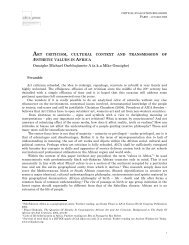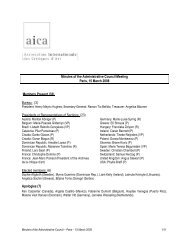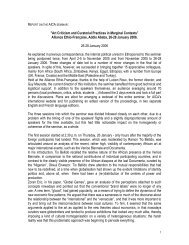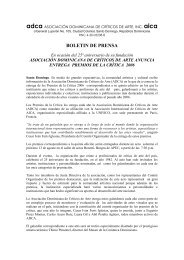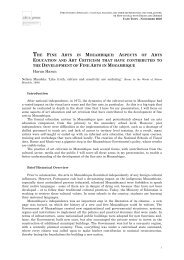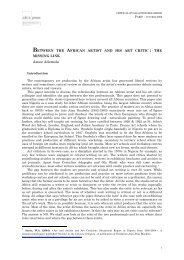Pierre Restany Pierre Restany's - AICA international
Pierre Restany Pierre Restany's - AICA international
Pierre Restany Pierre Restany's - AICA international
You also want an ePaper? Increase the reach of your titles
YUMPU automatically turns print PDFs into web optimized ePapers that Google loves.
Marianne Bordreau prépare une thèse, sous la direction<br />
de Jean-Marc Poinsot, sur le rôle du critique d’art dans<br />
les manifestations <strong>international</strong>es et l’attribution des<br />
prix dans les années 1950-60, en prenant l’exemple de<br />
<strong>Pierre</strong> <strong>Restany</strong>. Elle collabore à la revue Critique d’Art et<br />
travaille régulièrement aux Archives de la critique d’art,<br />
pour participer à la mise à jour du fonds <strong>Restany</strong>.<br />
Marianne Bordreau is currently preparing a thesis (dir.<br />
Jean-Marc Poinsot) on the role of art critics in <strong>international</strong><br />
art events and the attribution of art prizes in the<br />
1950s and 1960s, taking <strong>Pierre</strong> <strong>Restany</strong> as her model.<br />
She is a collaborator on the review Critique d’Art and<br />
works regularly on the updating of the <strong>Restany</strong> archive<br />
at the French Archives de la critique d’art.<br />
Renaud Bouchet<br />
Une dynamique séduisante :<br />
le Nouveau Réalisme de <strong>Pierre</strong> <strong>Restany</strong><br />
Traditionnellement appliquée au groupe des Nouveaux<br />
Réalistes, l’image d’une organisation associative composée<br />
d’amis unis dans la célébration de l’objet issu de la<br />
civilisation urbaine résiste difficilement à l’examen des<br />
faits. Dès lors, où rechercher la cause première de l’alliance<br />
des treize acteurs du mouvement sous le mot d’ordre<br />
des « nouvelles approches perceptives du réel » imposé<br />
par <strong>Pierre</strong> <strong>Restany</strong> C’est une lecture plus prosaïque de<br />
l’histoire du Nouveau Réalisme qui est ici proposée, à<br />
travers l’analyse du pouvoir d’attraction exercé par le<br />
critique et son projet néo-réaliste chez Arman et César,<br />
dans l’optique de l’impératif de carrière individuelle.<br />
<strong>Pierre</strong> <strong>Restany</strong>’s Nouveau Réalisme:<br />
A seductive dynamic<br />
The traditional image of the Nouveaux Réalistes – as an<br />
association of friends united in their celebration of the<br />
mass-produced objects of urban civilization – fails to<br />
stand up to a closer scrutiny of the facts. Where, then,<br />
should we look for the prime causes of the alliance of<br />
the movement’s thirteen key players, seekers after “new<br />
approaches to the perception of reality”, as identified<br />
by <strong>Pierre</strong> <strong>Restany</strong> The paper proposes a more prosaic<br />
reading of the history of Nouveau Réalisme: <strong>Restany</strong> and<br />
his Néo-Réaliste project exerted a powerful attraction for<br />
artists such as Arman and César, who saw it as a vehicle<br />
for the furtherance of their individual careers.<br />
Renaud Bouchet prépare une thèse de doctorat consacrée<br />
à l’œuvre soudée et compressée de César (dir.<br />
Jean-Paul Bouillon, université Clermont-Ferrand II). Il<br />
est l’auteur des articles : « Poubelles et Accumulations.<br />
Le Nouveau Réalisme de <strong>Pierre</strong> <strong>Restany</strong> à l’épreuve de<br />
l’œuvre d’Arman », « Dialogue épistolaire avec <strong>Pierre</strong><br />
<strong>Restany</strong> autour des Poubelles d’Arman (mai 2001 - décembre<br />
2002) » (Cahiers du Mnam, n° 96, été 2006),<br />
« Arman et les Nouveaux Réalistes : origines et résultats<br />
d’une adhésion de circonstance » (Recherches en<br />
Histoire de l’art, n° 4, 2006), « Arman et sa réception<br />
outre-Atlantique (1961-1965) » (à paraître dans la revue<br />
Histoire de l’art).<br />
Renaud Bouchet is currently preparing a doctoral thesis<br />
on the soldered and compressed work of the French<br />
sculptor César (dir. Jean-Paul Bouillon, at the University of<br />
Clermont-Ferrand). His is the author of a number of published<br />
articles: “Poubelles et Accumulations. Le Nouveau<br />
Réalisme de <strong>Pierre</strong> <strong>Restany</strong> à l’épreuve de l’œuvre d’Arman“<br />
; “Dialogue épistolaire avec <strong>Pierre</strong> <strong>Restany</strong> autour<br />
des Poubelles d’Arman (mai 2001 - décembre 2002)“<br />
in Cahiers du Mnam, n° 96, summer 2006 ; ”Arman et<br />
les Nouveaux Réalistes: origines et résultats d’une adhésion<br />
de circonstance“, in Recherches en Histoire de l’art,<br />
n°4, 2006; and ”Arman et sa réception outre-Atlantique<br />
(1961-1965)“, forthcoming in Histoire de l’Art.<br />
Nicolas Bourriaud<br />
Nicolas Bourriaud est critique d’art et commissaire<br />
d’expositions. Chief curator de la fondation Victor Pinchuk<br />
à Kiev, il enseigne à la Faculty of Arts & Design<br />
de l’université de Venise. Il est le co-fondateur, avec<br />
Jérôme Sans, du Palais de Tokyo qu’il a dirigé de 1999<br />
à 2006. Il a notamment publié L’Esthétique relationnelle<br />
(1998), Formes de vie – l’art moderne et l’invention de<br />
soi (1999), Postproduction (2001) et a été commissaire<br />
de nombreuses expositions dont Traffic (1996, CAPC de<br />
Bordeaux), Playlist (2004, Palais de Tokyo), la Biennale<br />
de Lyon (2005), la Biennale de Moscou (2005 et 2007). Il<br />
a été, avec Jérôme Sans, directeur artistique de l’édition<br />
2006 de Nuit Blanche.<br />
Nicolas Bourriaud is an art critic and exhibition curator.<br />
He is curator-in-chief of the Victor Pinchuk Foundation in<br />
Kiev, and teaches at the University of Venice (Faculty of<br />
Arts & Design). He co-founded the Palais de Tokyo contemporary<br />
art space in Paris with Jérôme Sans, and was<br />
its director from 1999 to 2006. His publications include<br />
L’Esthétique relationnelle (1998), Formes de vie – l’art<br />
moderne et l’invention de soi (1999) and Postproduction<br />
(2001). He has curated numerous exhibitions including<br />
Traffic (1996, CAPC in Bordeaux), Playlist (2004, Palais<br />
de Tokyo), the Lyon Biennale (2005), and the Moscow<br />
Biennale (2005 and 2007). Together with Jérôme Sans,<br />
he was artistic director of Paris’s fifth Nuit Blanche festival,<br />
held in the city on the night of October 7, 2006.<br />
17


